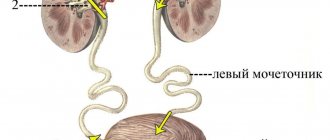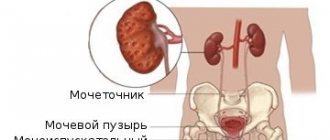- hormonal changes in the body (for example, during puberty, pregnancy),
urolithiasis disease,
Untimely emptying of the bladder leads to the reflux of urine into the upper parts and their infection.
In 90 cases, purulent lesions are caused by Staphylococcus aureus.
General information
Kidney carbuncle is one of the forms of purulent lesions of the urinary system. Its peculiarity is the predominance of necrosis in pathogenesis, resulting in particularly pronounced intoxication of the body. Often combined with purulent pyelonephritis and apostematous nephritis, there is an opinion that these three conditions are different stages of one purulent-inflammatory pathological process.
In women, the disease is somewhat more common, which is due to the anatomical features of the urinary system, which facilitate the ascending penetration of infection. Sometimes there is a certain seasonality of incidence with an increase in the number of cases in the cold season, the provoking factor being hypothermia.
Often combined with purulent pyelonephritis and apostematous nephritis, there is an opinion that these three conditions are different stages of one purulent-inflammatory pathological process.
Symptoms
Manifestations of kidney carbuncle depend on the form of the disease. They are presented in the table:
| Acute form | Hidden current (latent form) |
| – pyretic temperature values; | – no increase in temperature is observed; |
| – excitement; | – signs of cardiovascular pathologies – arrhythmia, tachycardia; |
| – chills; | – epigastric pain; |
| - nausea; | - nausea; |
| - nonsense; | – violation of defecation; |
| – pain in the lower back, which gradually spreads to the area of the affected organ; | – jaundice; |
| – swelling in the projection of the inflammatory focus; | – signs of liver failure. |
| – the development of symptoms of an “acute abdomen” is possible. | The latent form is easily confused with other ailments. |
Anuria rarely develops, as do other forms of urinary dysfunction. Pasternatsky syndrome – pain during percussion in the projection of the affected organ, accompanied by the release of red blood cells into the urine – negative.
The inflammatory process can spread to the pleura and adrenal glands.
The inflammatory process can spread to the pleura and adrenal glands.
Diagnostic methods
It is not easy to identify a renal carbuncle, since the patient does not always develop swelling in the renal area. With purulent formation in the pelvis, urine examination indicates an increased concentration of leukocytes.
If the abscess is located in the cortical region, then the outflow of urine occurs as usual. This makes it difficult to identify the disease.
The specialist’s task is to distinguish pathology from tumor formations and other ailments. For this, the following diagnostic methods are used:
- ultrasound examination of the kidneys, ureters;
- urography;
- MRI;
- laboratory tests.
With a single detection of a carbuncle, often no changes occur in the urine. Violation of indicators is recorded during acute inflammatory phenomena in the urinary system.
This treatment has a positive therapeutic effect in almost all patients.
Causes
This infectious disease is a type of acute bacterial inflammation of the kidneys (pyelonephritis) or manifests itself as a result of the penetration of infectious agents through the hematogenous route into healthy kidney tissue in the presence of any other chronic foci of infection.
Quite often, the occurrence of infiltration is associated with diseases such as: lactostasis with the development of mastitis, upper respiratory tract infections, pustular skin lesions, furunculosis of other localization, panaritium, peritonsillar abscess, etc.
During kidney damage, patients often forget about the primary purulent focus. The formation of a carbuncle is possible when the passage of urine is impaired due to obstruction of the ureters with stones, the presence of bladder cancer, prostate cancer, prostate adenoma, pregnancy, urethral stricture.
There are also some risk factors that may affect the development of infectious pathology:
- Diabetes.
- Weakened immune system.
- Dermatitis.
- Chronic kidney diseases.
- Infectious diseases of other organs or systems.
- Poor hygiene.
- Elderly age.
- Obesity.
- Liver diseases.
There are several mechanisms for the development of kidney carbuncle:
- The septic embolus enters the renal artery, causing septic infarction of the kidney and the formation of a round infectious infiltrate.
- The branch of the artery may not be completely obstructed by the embolism, but a pathological process of inflammation begins to develop.
- Hematogenous dissemination of pathogens from the source of infection located in other organs or systems.
The most common pathogens are representatives of gram-negative (Escherichia coli, Proteus, Pseudomonas aeruginosa) and mixed flora.
In the segment that surrounds the affected area, inflammatory infiltration occurs with the formation of a granulation shaft, which prevents the spread of infection to healthy tissue. The inflammatory process can spread to the area of the calyx and renal pelvis.
A reactive edema forms in the adrenal tissues, and then a focus of purulent decay, often with the formation of a paranephritic abscess . After the infected contents of convoluted tubules of the second order break through into the connective tissue of the kidney, inflammation of the interstitial tissue begins.
The process has a pronounced focal character. In the connective tissue, leukocyte infiltrates can be seen around the collecting ducts. With timely assistance, the inflammatory process may subside.
The above clinical signs may manifest differently in patients.
Causes
There are several main ways that infectious pathogens enter the renal parenchyma, with the subsequent formation of single or multiple carbuncles. These methods include:
- Hematogenous method. In this situation, the introduction of infectious pathogens occurs through the bloodstream, when bacteria enter from an existing infectious-inflammatory focus through blood vessels into the parenchyma of the paired organ. Kidney carbuncle often occurs as a complication of diseases such as tonsillitis, inflammatory lesions of the mammary glands in women, furunculosis, as well as purulent-necrotic bone lesions.
- Lymphogenic method. Infection through lymphatic vessels occurs in diseases such as infectious and inflammatory damage to the organs of the reproductive system and large intestine.
- Bottom-up method. The most likely route of infection of the urinary tract is the ascending route, in which bacteria, viruses or fungi enter the kidneys through the urethra, bladder and ureters.
Important! In 90% of cases of diagnosed kidney carbuncle, infectious focal changes in the organ are triggered by the entry and rapid proliferation of Staphylococcus aureus. Less common causative agents of the disease are Pseudomonas aeruginosa and Escherichia coli, enterococci and Proteus.
Not every person has a predisposition to the development of multiple or single carbuncles in the kidney area. There is a list of predisposing factors that automatically increase the likelihood of developing this pathology. These factors include:
- Regular exposure to low temperatures. Long-term regular hypothermia of the body adversely affects the general condition of the body and renal activity.
- Angina pectoris.
- Regular and long-term artificial urinary retention. If the bladder is not emptied in a timely manner, favorable conditions are created for the proliferation of bacterial microflora, which can ascend through the ureters into the kidney parenchyma, causing infectious and inflammatory changes.
- Decrease in the body's defenses.
- Impact of ionizing radiation on the human body.
- Long-term uncontrolled use of antibacterial agents.
- Previously undergone surgical interventions on the organs of the reproductive and urinary system.
- Hormonal changes characteristic of puberty, as well as the period of bearing a child.
- Severe poisoning with chemical compounds such as arsenic, lead and chlorine.
- Predisposition to the formation of kidney and bladder stones (urolithiasis).
- Benign and malignant neoplasms in the prostate gland and bladder.
- Pathological conditions that are accompanied by disruption of the natural process of urine excretion, as well as retrograde reflux of urine into the renal pelvis.
- Congenital and acquired anomalies and structural defects of the urinary organs, including strictures, adhesions and deformations.
Mechanism of disease development
In the process of formation and development of the carbuncle, experts distinguish 2 stages.
- First stage. In a certain area of the kidney cortex, blood circulation becomes difficult (due to the blocking of blood vessels by a thrombus of bacterial origin). Here the inflammatory process actively develops, a specific compaction is formed - tissue infiltration. The affected area swells.
The listed phenomena are clearly visualized during an ultrasound scan of the kidneys. By consulting a doctor in a timely manner, it will be possible to stop the pathological process. To do this, you will need to notify the doctor about the disturbing symptoms - main and additional, and on the part of the urologist - prescribe competent treatment and control over its implementation.
The lack of adequate therapy causes inflammation to transfer to the walls of arterioles (anatomically they lie through the source of inflammation). Under the influence of pathogens, arterioles swell, become blocked, blood transportation worsens, and then practically stops. As a result, the cells of the kidney area, insufficiently supplied with oxygen, die. The phenomenon is defined as a “heart attack.”
- Second stage. Bacterial microflora invades the area of necrotic tissue. Under the influence of staphylococci, the tissues completely disintegrate, and the area of dead tissue is affected by suppuration. As a result of pathological processes, a limited focus of purulent-necrotic nature is formed - a carbuncle. The size of the tumor varies, sometimes exceeding the size of a chicken egg.
For a long time, the purulent focus is characterized by clearly defined boundaries. Since full blood circulation and its supply to tissues ceases, the cover becomes saturated with purulent mass. According to clinical symptoms, the presence of a kidney carbuncle resembles signs of the development of a similar suppuration, but on the skin.
Symptoms
Single or multiple carbuncles in the kidney area lead to the development of a serious condition, which is conventionally divided into the period of integrity of purulent formations, as well as the period of breakthrough of foci. Until the rupture of local purulent formations, a person is faced with a list of the following clinical symptoms:
- An increase in body temperature to 39 degrees and above.
- Excessive sweating and chills.
- Intense aching or dull pain in the lumbar region on the left or right.
- General weakness and malaise, decreased performance.
- Reflex vomiting.
In addition, patients with a similar diagnosis tend to take a forced position, while lying on the side of the injury, bending the lower limbs at the knee joints and pressing them to the stomach.
From the moment of rupture of focal purulent elements, the clinical symptoms weaken, the person’s body temperature decreases and the intensity of the pain syndrome decreases.
What is kidney carbuncle?
Kidney carbuncle is a pathology, one of the types of pyelonephritis, which is a pathology that develops in a certain area of the renal cortex.
It is difficult to diagnose and carries a high risk, as it can completely negate the functioning of the kidneys.
Causes of kidney carbuncle
The occurrence of a kidney carbuncle is most often associated with the penetration of foreign microflora into the kidneys of sick patients. There are a number of bacteria and pathologies that contribute to the development of the disease.
- Introduction of staphylococcus bacteria into the kidneys;
- Acute pyelonephritis that did not receive proper treatment on time;
- Various types of tumors.
Kidney carbuncle, as a rule, is preceded by other diseases: boils, skin carbuncle, inflammation of the respiratory tract, mastitis, abscesses, panaritium and many others.
The cause is sometimes difficult to find due to the fact that when the disease begins, the patient does not remember its possible causes.
Causes may also be: malignant tumors of the genitourinary system, pregnancy, urethritis and any other narrowing of the hollow structure of the system.
Diseases against which a carbuncle develops:
- Diabetes;
- Systemic lupus;
- Ischemic diseases;
- Pancreatitis and cholecystitis.
Stages of development
A carbuncle, as a rule, develops in two stages that form it:
- In the place of poor blood flow, inflammation appears and grows, surrounded by edema. This stage of the inflammatory process, with proper therapy and timely detection, stops and is treated fairly quickly. If left untreated, the disease progresses and penetrates into the organ and cell death occurs.
- At this stage, staphylococcus enters the lesion, causing necrosis and rotting. Ultimately, a local purulent-necrotic formation is formed, ranging in size from a grain of rice to the size of a tennis ball.
Rehabilitation
During the recovery period, the patient is prescribed antibiotics and procedures that remove the remains of poisons. Rehabilitation is gradual, as many symptoms remain temporarily after surgery. Body temperature and intoxication decrease within one or two weeks. Swelling is usually relieved by laser procedures.
Kidney function is restored depending on the complexity of the operation. In the case where the kidney remains, rehabilitation is much faster. With one remaining kidney, everything takes a longer time, but nevertheless, the remaining kidney is quite capable of serving the entire body without any special difficulties.
Subsequently, the body is restored almost to its original state and patients rarely complain of discomfort and pain.
Complication
If the disease was not diagnosed in time and treatment was unsuccessful, serious complications are possible that can cause irreparable harm to the body:
- Respiratory tract disease, pleural inflammation and pulmonary insufficiency;
- Damage to toxins and swelling of the respiratory organs;
- Proliferation of purulent inflammation to nearby organs.
Prevention
To prevent carbuncle, you simply need to treat all pathologies on time and not let the situation reach an extreme stage. If the disease cannot be prevented, then you need to immediately go to the doctor. Listen to your body and do not ignore the first “calls” of your body.
It makes sense to periodically undergo examination by a urologist and undergo ultrasound or x-rays, in which case the likelihood of developing the disease and complications from it decreases.
Source: https://pochkam.ru/bolezni-pochek/karbunkul-pochki.html
Diagnostics
In making a clinical diagnosis, a key role is played by laboratory and instrumental diagnostic methods, as well as a physical examination of a patient with characteristic complaints.
Physical
During a general medical examination, the development of a pathological process in the kidney area may be indicated by the characteristic pale or earthy color of the skin, as well as the patient’s pained facial expressions. Pain syndrome with single or multiple carbuncles in the kidney area is accompanied by an increase in heart rate, as well as rapid breathing.
The general physical examination includes palpation of both kidneys, while on the affected side an increase in pain when pressed is determined, and an enlarged kidney is clearly palpated. Also, focal purulent changes in the paired organ are characterized by muscle tension in the lumbar region, as well as the muscular apparatus of the anterior abdominal wall.
Laboratory
Laboratory methods for diagnosing this disease include:
- General clinical examination of urine. The results of the analysis indicate severe leukocyturia, proteinuria and hematuria.
- Bacteriological examination of urine. To confirm the infectious nature of the disease, patients undergo bacteriological culture of urine on a nutrient medium. In order for the analysis to be as reliable as possible, it is important to pay special attention to the collection of biomaterial, which must be carried out in a sterile container.
- General clinical blood test. With the development of a purulent-inflammatory focus, the percentage of leukocytes in the systemic bloodstream will increase and the ESR will increase.
Important! In order for the treatment of this pathology to be effective, before prescribing medications, medical specialists perform an antibiogram, which allows one to assess the level of sensitivity of bacteria to certain types of antibiotics.
Instrumental
Along with laboratory examination methods, the clinical diagnosis can be confirmed using instrumental techniques. These methods include:
- Ultrasound examination of a paired organ with Doppler function.
- Review version of radiography of the kidneys. With the development of single or multiple carbuncles in the kidney, purulent-inflammatory foci will be clearly visualized on an x-ray.
- Method of intravenous urography. In order to improve visualization of the organ being examined, the patient is injected intravenously with a radiopaque contrast agent, after which a series of X-ray images are taken at intervals of several minutes. If the diagnosis is positive, the x-ray will reveal compression of the renal pelvis or calyces by the carbuncle.
- Computer or magnetic resonance imaging.
Drug therapy
Medicines for kidneys and formations in them are sold in many pharmacies. However, such medications should only be taken as prescribed by an experienced doctor.
Many experts argue that even after successful treatment of a kidney carbuncle, it can recur. As a rule, this happens if the cause of its occurrence has not been completely eliminated.
If a carbuncle is detected in the early stages of its development, patients may be offered treatment with antibiotics, but only strictly under the supervision of a urologist. It should be noted that in most cases such therapy does not give the desired results, since purulent formation significantly impedes blood flow in the kidney, which does not allow antibacterial substances to penetrate into the lesion.
Recently, the disease in question began to be treated comprehensively, using not only antibacterial drugs, but also a remedy such as “Cryoprecipitate”. The latter is a kind of concentrated mixture obtained from blood plasma. Treatment with this medicine helps to increase the level of fibronectin in the blood, which subsequently helps restore blood flow to the affected areas of the kidneys.
Treatment
Operational
The only, most effective way to eliminate a purulent-inflammatory focus is surgical intervention.
Access to the paired organ is gained through the lumbar region, by layer-by-layer dissection of the skin, subcutaneous fatty tissue, and muscle-fascial layer. After identifying a local purulent focus, it is opened, purulent contents and necrotic tissue are removed, the wound surface is cleaned with an antiseptic solution, and a special drainage is installed. After layer-by-layer suturing of the wound, a medical specialist examines the seam and performs a dressing.
In order to prevent infectious complications, each patient is prescribed a course of antibiotic therapy, the duration of which is from 7 to 10 days. If the renal carbuncle has damaged a large area of the paired organ, the patient may require a kidney transplant.
Alternative
In order to remove small and single carbuncles, the cryotherapy technique can be used. During the procedure, an abscess on the kidney is opened through an endoscopic approach in the lumbar region. After this, the purulent focus is exposed to a temperature of -160 °C. The total duration of exposure is 10 seconds.
Conservative treatment using antibacterial agents can be effective only in the initial stages of carbuncle development. To combat infection, they prefer to use drugs such as Cefepime, Cefotaxime, Ciprofloxacin, Amoxiclav and Ceftriaxone.
Any methods of physiotherapy and herbal medicine for diagnosed renal carbuncle are ineffective.
Features of the disease in humans
It is important to know what this type of carbuncle looks like. Externally, the pathology resembles a subcutaneous carbuncle and looks like a rounded convex formation. In the section, non-viable tissue is observed, saturated with small pustules that have merged with each other.
The disease code for kidney carbuncle according to ICD-10 (International Classification of Diseases) is L02.8 with the name “Skin abscess, boil and carbuncle of other localizations.”
In half of the pathology development stories, the renal carbuncle occurs against the background of apostematous pyelonephritis (inflammation of the kidneys with the formation of a large number of small abscesses - apostem), so the pathologies do not have pronounced differences in clinical manifestations.
Complications
With timely diagnosis and radical removal of the purulent-inflammatory focus, the kidney carbuncle does not pose a danger to human health and life. Delayed treatment can lead to the development of such serious complications:
- Kidney abscess. This complication occurs as a result of rupture of the carbuncle.
- Septic complications that occur when an infection spreads through the bloodstream.
- Retroperitoneal phlegmon, it is formed when the contents of the carbuncle enter the fatty tissue that surrounds the paired organ.
Stages and forms
There are two main stages in the formation of a kidney carbuncle:
- The first stage lasts about 14 days. An inflammatory process occurs in the kidney tissue, macrophages and leukocytes migrate from the bloodstream to foreign cells. Timely treatment can stop the further development of the infectious process before it enters the second stage.
- At the second stage, final tissue necrosis occurs with the formation of pus. As a result, a single or multiple carbuncle of various sizes is formed.
There are the following forms of this disease:
- Typical with a classic clinical picture of acute inflammation.
- Atypical with erased symptoms.










